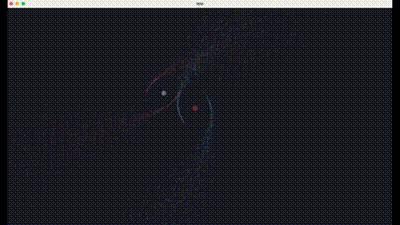3 releases
| 0.1.2 | Apr 28, 2022 |
|---|---|
| 0.1.1 | Apr 25, 2022 |
| 0.1.0 | Apr 25, 2022 |
#248 in Simulation
27KB
563 lines
Miniverse
A library for simulating n-body gravity interactions, written in Rust using the Bevy game engine.
This project looks to provide an easy to use gravity simulation.
Getting started
cargo new my_universe
cd my_universe
Add miniverse as a dependency in your cargo.toml.
miniverse = "0.1.2"
In your main file write out the galaxy example:
extern crate miniverse;
use miniverse::{colors, Galaxy, Simulation, Vec3};
const TIME_STEP: f32 = 1.0 / 60.0;
const G: f32 = 10.0;
const PARTICLE_RADIUS: f32 = 0.05;
fn main() {
let camera_pos: Vec3 = Vec3::new(0.0, 0.0, -75.0);
let mut sim = Simulation::new(TIME_STEP, G, PARTICLE_RADIUS, camera_pos, colors::gray_dark);
let systems = vec![Galaxy {
amount: 5000,
arms: 3,
center_mass: 5.0,
center_pos: Vec3::new(0.0, 0.0, 0.0),
center_vel: Vec3::new(0.0, 0.0, 0.0),
normal: Vec3::new(0.0, 0.0, 1.0),
particle_color: colors::blue,
center_color: colors::gray_light,
}];
sim.config(systems);
sim.run();
}
Build and run! Preferably build in release mode for smoother simulations.
cargo build --release
cargo run --release
Camera
Camera movement can be controlled:
w- ina- lefts- rightd- outspace- upshift- down
Camera rotation (pitch & yaw) can be controlled with mouse.
Next steps
Get familiarized with the API :)
API
The idea is that pre-defined systems (called Prefabs) are simply inserted into the simulation, and then run together. There are 4 types of systems so far:
- Particle
- Body
- Galaxy
- Asteroid Belt
Following the example above, when declaring the systems vec, simply insert your Prefabs:
let systems = vec![
Body {
mass: 10.0,
radius: 5.0,
color: colors::yellow,
initial_position: Vec3::new(0.0, 0.0, 0.0),
initial_velocity: Vec3::new(0.0, 0.0, 0.0),
},
AsteroidBelt {
amount: 700,
radius: 85.0,
center_mass: 10.0,
center_pos: Vec3::new(0.0, 0.0, 0.0),
center_vel: Vec3::new(0.0, 0.0, 0.0),
normal: Vec3::new(0.0, 0.0, 1.0),
particle_color: colors::gray_light,
},
];
Check out the our examples. Also check out the documentation.
Notes on the code
Particle optimization
Particles are taken as massless, since their values are neglible compared to larger objects. This really helps out in optimizing the code using Bevy's ECS for gravity interaction calculation.
Algorithm
Velocity verlet algorithm used applied to gravitational differential equations.
Initial algorithm used, was already coded into Bevy's examples.
Galaxy generation
The code for galaxy generation (the spirals), was used from this amazing repo.
Future improvements
- Muli-threaded computations
- Integration methods
- Better documentation
- Testing modules
- Energy and momentum analysis
- Specific particle tracking
- Collisions (inelastic and elastic) --> maybe a cofficient of elasticity
- Pausing
Dependencies
~34–48MB
~825K SLoC
